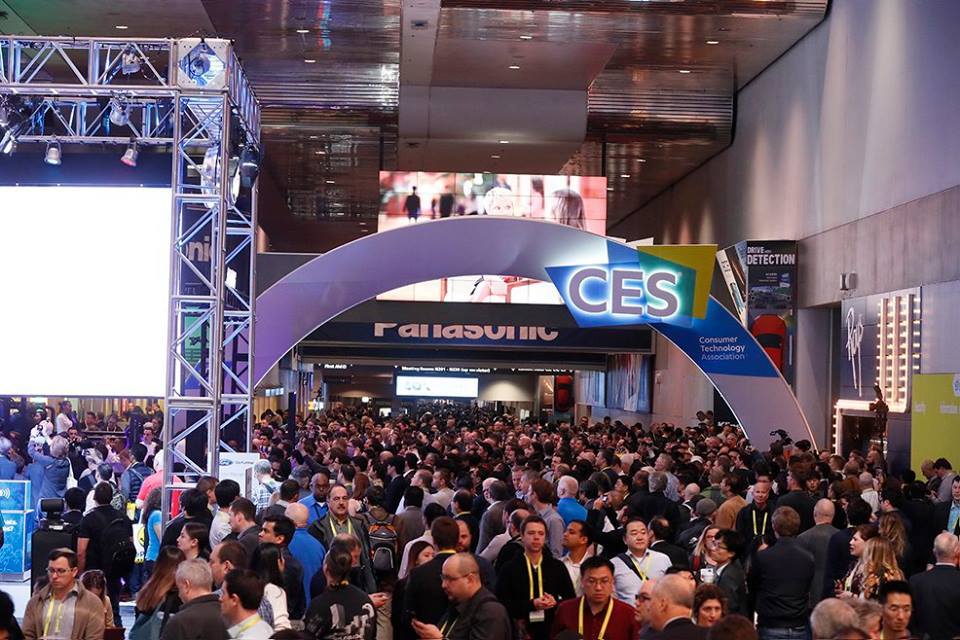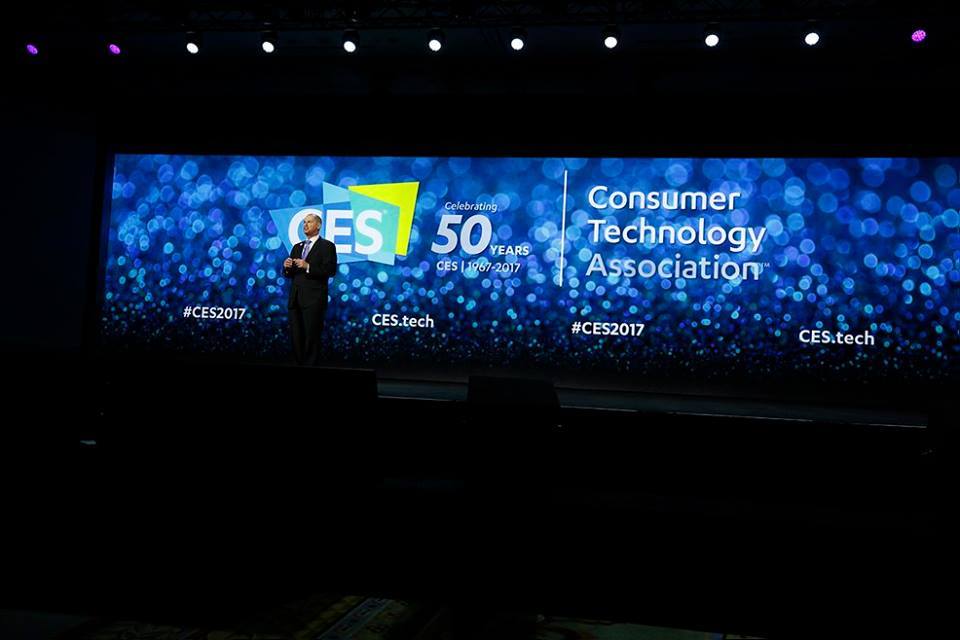CES 2017: payment, e-commerce and fintech trends
- Transfer
This year I was among 160 thousand industry colleagues who had the opportunity to visit CES. At the event, I participated in a series of discussions on the topic of commerce and payments in the digital age. It all started with a discussion of the so-called growth in the popularity of payment using mobile wallets through POS-terminals. “Growing popularity”, however, can hardly be called correct given the research data that confidently speak in favor of the opposite. The final part was dedicated to the unanimous expression of the industry representatives' love for blockchain technology, any attempts to argue with which caused a grin.
Voice platforms begin to play an increasing role in the future of commerce
Mobile wallet applications and contactless payment systems failed to win the hearts of consumers and this state of things, quite possibly, will never change.

Source: Facebook, @CES
Contactless payment systems got stuck at the level of statistics in March 2015, according to which 19 out of 20 consumers who had a real opportunity to make purchases at POS cash registers using Apple Pay did not use the services of the longest such experiment on the market. It is difficult to say what else can be done to change the current state of affairs, especially taking into account the emergence after a year of a much larger number of alternative ways to use phones for payments. It would be logical to assume that in the light of the terribly unloved by all the need to insert bank cards in the terminal to make payment, consumers should already fall for this bait. However, this did not happen and the market still lacks solutions,
Apparently, the most real and relevant solution to this problem today is the concept of mobile pre-orders. Starbucks experience has shown that a third of the coffee giant’s mobile customers are hooked on the service. As for the traditional retailers in general, they welcomed the idea cordially, because it gives them the opportunity to attract more visitors to the premises of their physical stores. In addition to everything else, the mobile pre-order eliminates one of the most urgent problems of consumers - the queue, and helps to find another answer to the question of finding additional sales sources that is always relevant for merchants.
As for the technology of tomorrow, a lot of attention was paid to voice control systems, and, of course, related commercial activities. Such systems can be called a dark horse in the market of commerce and payments, which can soon become a popular and effective solution.
In the past, I wrote about the potential of Amazon Alexa.and its ability to qualitatively change consumers' approach to the use of voice for commercial purposes. At that time, Alexa had several hundred skills, was “tied” to the smart dynamics of Echo and was very straightforward in communicating with consumers. Now, thanks to the openness of the system and the efforts of third-party developers who use a special proprietary set of tools to work with it, Alexa's skill box has grown to 7,000 algorithms, and she herself has learned to match requests with context and has become available as an integrated solution in cars, devices, robots, and soon as an application on Huawei Android smartphones. Alexa, which once used to poison flat jokes and was only suitable for making a shopping list, today serves as the basis for new skills-based cases, such as ordering pizza from Domino, traveling to Uber,
Payment of all these features, of course, is carried out using the Amazon payment system. Activating commerce-related skills only requires linking to an Amazon user account. Thus, the combination of Amazon Payments and the company's voice services can seriously shake the position of mobile wallets as intermediaries in the field of payments and begin to dictate their conditions to mobile ecosystems due to the popularity and wide range of services provided.

Source: Facebook, @CES
It is not surprising that Google and its new service Allo, Apple and Microsoft with their assistants Siri and Cortana, as well as Samsung with their new voice assistant Bixby, have actively entered the game, providing users with their own know-how and variations on the topic, designed to interest them. However, all these companies, including Apple, are catching up, trying to catch up with the ecosystem that successfully and quickly managed to attract developers to their voice platform, which users increasingly use as their best friend for voice authorization of payments and facilitate payment process.
However, the most interesting is the degree of user involvement in working with Alexa, which was not achieved by any contactless payment service, be it Apple, Android or Samsung Pay. As a result of this popularity, sales of devices providing access to Alexa skills are also growing.
Amazon managed to make the new platform convenient for consumers by providing them with answers to common queries - weather forecasts, answers to simple questions, and music playback. This was followed by the introduction of skills to solve the obvious commercial, banking, and payment problems of users, such as checking balances, paying bills, ordering food, and buying things online. And this is exactly the level to which competitors of the company will try to reach in the near future.
Banks seize initiative in fintech market
Banks operate in an ecosystem whose members are very dependent on each other, and any of their actions always have significant consequences outside their own walls. And, of course, banking organizations are subjected to serious inspections by regulatory authorities, the requirements of which are being tightened every year in all markets of the world. Therefore, no matter how positive such financial institutions may be towards innovation, they simply cannot afford to abandon everything “old” and start all over from scratch.

Source: Facebook, @CES
Be that as it may, at CES 2017 all the expert panels nudged the problems of traditional banks and their solutions: “blockchain as an alternative to outdated infrastructure”, “digital banking as a replacement for physical branches”, “banking models and products are too expensive, new models will appear and then banking decisions will lose their relevance ”and so on.
The problem, however, is that among these new vaunted models there is not one that can scale due to its own efforts. Most of them rely on banking systems for these purposes. And this is not to mention the fact that without the mediation of banks, none of them could have achieved any results at all.
Of course, all this does not mean that banks should not look for ways to introduce innovations, which they have not done for a long time. The most recent innovations launched and massively popularized by banks include the concept of online and mobile banking, as well as the remote digitization of checks on the account. Often during their development, they used the innovations of third-party companies. In the new year, banks will need to continue mutually beneficial cooperation with fintech players in order to solve current user problems. At the same time, financial institutions are likely to devote maximum resources and efforts to innovations and investments in the so-called RegTech (legal regulation and related new technologies), with the aim of its application as a way to improve and strengthen risk management practices and internal audit.
Cool apps need to be more than cool.
A lot of time at the event was devoted to discussing the next major consumer crisis - the inability of the so-called generation of baby boomers to retire with a stable financial situation, and similar problems of generation X and millennials who do not resort to saving money, as well as the inability of most consumers to put off even a trifle $ 400 in case of emergency.

Source: Facebook, @CES
I recently wrote about the upcoming fintech crisis of the millennialsthat can have a huge impact on all payment and commercial ecosystems. It was about a unique study by a group of Stanford scientists, according to which 50% of millennials from middle-income families can never earn more than their parents. For families with lower incomes, the picture is even darker. Of course, the lack of funds for such a large category of people leads to their inability to buy, save, or even gain access to cash loans.
Of course, today on the market there are many tools invented by innovators to help all consumer groups overcome such financial difficulties. We have robo-advisers who are able to create and plan a budget, online platforms for creating investment plans, focused on ensuring financial stability in retirement age and other needs. In addition, there are savings platforms that allow consumers to save, and transactional loan programs that can improve the credit rating for each individual purchase. Such programs are gradually gaining momentum, but only a very small percentage of them managed to gain a critical mass of users. Most of them are trying to find ways to monetize as standalone applications. Probably all of this suggests
That is, it is also important to tell consumers why they need cool applications and stimulate the formation of appropriate habits among users. The question remains open about which players are in the most favorable position for cooperation with innovators and what position banks and retailers will take in this matter.
Blockchain replaced Bitcoin as a “hot thing” of fintech
Another hot topic of CES 2017 was blockchain and Bitcoin, the mention of which could be heard very often.
In this regard, one cannot fail to note the serious mood of the blockchain community, seeking to implement its mission of global replacement of absolutely all elements of the existing payment, commercial and financial infrastructure with distributed registries. Blockchain is positioned neither more nor less than a universal remedy for all diseases of the international financial system. Statistics claim that all up to one company in the Fortune 100 list already has its own blockchain project in their hands, while those who do not already have it are in a hurry to join the others. According to some reports, the blockchain and Bitcoin ecosystems will attract trillions of dollars of investment injections in the next few years. And as soon as central banks join the process, there will be no doubt about the bright future of the market.

Source: Facebook,@CES
General impressions are that the industry is doing its best.
However, is there someone in it who should be remembered by name? The concept of the blockchain continues to remain in the early stages of development, being still more like a scientific experiment, consisting of many new pilot projects exploring the possibilities of technology in a particular context. And if earlier we believed that trillions of dollars would move around the world through public blockchains on Bitcoin's “rails”, now the focus of attention has shifted to private blockchains and other digital currencies. Of course, the concept of a distributed registry that makes instant clearing and settlement all over the world possible is still attractive. The reality, however, is that the realization of this idea comes up against the need for a thorough study of a new authoritative and regulated global infrastructure - a project
And we also have Bitcoin.
One of the conference participants once called Bitcoin 1.0 the currency of the drug commissar, as if making it clear that in the case of Bitcoin 2.0, this reputation remained in the past. Indeed, instead, it gradually turned into the currency of cybercriminals and ransomware programs, as a result of which its chances of playing the role of a new global currency have never been so low. In addition to the two just mentioned scenarios for the use of cryptocurrency, the third and most popular at the moment is a scheme for avoiding state capital control in China with a view to its subsequent withdrawal to other countries. Such an outflow of funds may provoke the government to take decisive action against Chinese miners, which, according to statistics, provide as much as 80% of all bitcoin mining activity.
Grass is not always greener on the other side
Another popular topic was the idea of China's superiority over the United States in the field of digital financial services, very reminiscent of the talk of experts from twenty years ago that Japan will overtake the United States and will soon rule the world.
There is no doubt that thanks to companies such as Alipay, Ant Financial and WeChat, China has long become a very innovative country. The WeChat digital ecosystem, embodying a variety of user cases in practice, including the direct transfer of funds between 400 million active users of the application, looks like a work of art. However, its success is the result of work to solve the pressing problems of Chinese consumers. It is about providing easy access to financial and payment services, through the skillful use of Chinese consumers' deeply rooted habits of using instant messaging on social networks where they spend a lot of time. Embedding commercial functions in such ecosystems was not only a logical step, but also a major change in user experience, an innovation.

Source: Facebook, @CES
However, do not cut everyone under one comb. Mobile payments were presented to American consumers as part of a very well-developed physical payment ecosystem, in which almost 100% of all commercial activities took place in physical stores, easily accessible for consumers and accepting bank cards for payment. The users experienced the most serious difficulties when trying to make online payments on Internet sites visited, as a rule, from home or office computers. It is the removal of these obstacles that is easily the basis for the activities of Amazon and PayPal, which began work in this direction in the mid-90s.
Therefore, in order to transfer consumers to “contactless payments”, you first need to convince them to quit their established and time-tested habits for the sake of the novelty of these services. The convenience of “old” methods from the very beginning raised the bar for new ones. For this reason, the popularization of contactless payments in stores remains a long and tedious process, and cloud-based mobile payments are gaining momentum. For the same reason, commerce in traditional social networks cannot "take off" in any way, and the development of commerce in messengers moves forward with difficulty. However, when it comes to mobile payments within applications, especially those that connect the online and offline world and allow you to pay in a mobile browser with one click, then the growth is obvious.
However, all this, of course, does not detract from the merits of innovators, each of which seeks to solve primarily the urgent problems of consumers in its market. However, instead of comparing them with each other, we should probably discuss what useful experience we could learn from both countries.
It's all about user experience
One of the most interesting discussions touched on the eternal mystery of the world of retailers and consumers: “What contributes to maintaining consumer loyalty and interest?” The dialogue was built around the topic of contactless payments and the search for ideas that could help to increase their popularity when paying for purchases in physical stores. The vast majority of participants came to the conclusion that reward programs should help. That is, merchants who want to become leaders need to integrate loyalty programs into their mobile applications, or, in other words, adapt the Starbucks mobile payment model.
As Samsung representatives said during the discussion that I led, the company is seeing positive momentum after introducing a reward just for the very fact of using any branded wallet application for any merchant. We are talking about Samsung Rewards - a program that encourages the habit of using Samsung Pay for any purchases from absolutely all merchants accepting this method of payment. Cashless and mobile payments operator USA Technologies talked about the effectiveness of its reward program for automated outlets and vending machines based on integration with Apple Pay, which motivates customers to choose this particular payment method.
But I posed other questions to those present: “Should loyalty programs always work on the principle of“ you to me, I to you ”? Do we really need to constantly “bribe” people so that they do what we expect from them? And what will happen when the "bribes" cease? " This approach is similar to building a house of cards on the foundation of the “Groupon effect”, which develops loyalty to one-time transactions, and not to the brand.
I asked the participants in the discussion about whether certain consumer experience can help to increase loyalty. In particular, what will happen to the loyalty of users of the Starbucks mobile application if the company refuses the reward program, since one third of its customers have already switched to mobile pre-order? What is more important for customers, free coffee or a convenient opportunity to refuse to stand in line to drink it?

Source: Facebook, @CES
Those present expressed the view that user experience - a thoughtful and competent approach to the provision of products and services - is, of course, more important. I think they are right and, in my opinion, when launching one or another program, one should always ask oneself: “What experience do I need to create so that clients come and remain interested in products?” Maybe it should be special offers or rewards, or maybe some richer and more meaningful experience, something that, so to speak, cannot be bought for money.
In general, if we talk about some general conclusion that I was able to draw based on the results of CES 2017, then it can be formulated as follows: “Think big and get down to solving big enough problems.” And then you can do something really meaningful, and after working hard, you will see how your work will grow to a noticeable size. Do not take an example from a hair brush connected to the network - one of the "new products" of the event, unable to do anything that cannot be handled by a conventional mirror that was invented hundreds of years ago.

